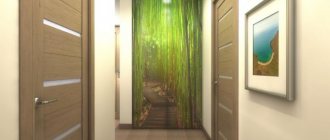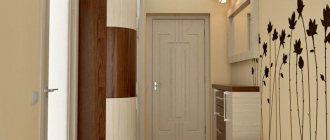A large selection of coatings creates difficulties for inexperienced developers when choosing a specific type of floor in the hallway. It is almost impossible to obtain objective information from advertising brochures of flooring manufacturers. The purpose of these articles is to increase the number of product sales and, accordingly, the profits of companies. Accordingly, 90% of the volume is devoted to advantages, 9% calls to purchase and only 1% disadvantages. This article will provide objective information about the various floor coverings in the hallway, their strengths and weaknesses.
Hallway floor
Light floor in the interior of a white hallway
What factors should be considered when choosing the type of flooring in the hallway
The service life of any coating largely depends on the correctness of the criteria for its selection. What should buyers consider before making their final decision?
In order for the hallway to look like a single and complete project, the design of the flooring should not “argue” with the rest of the decoration
Table. Criteria for choosing flooring.
| Selection factors | Brief description of parameters |
| Wear resistance | The hallway is a small room in which outer clothing and shoes are removed. This causes increased mechanical stress on the floor coverings. The floor must have increased mechanical strength. |
| Moisture resistance | In winter, there can be a lot of snow on your shoes; when it gets into a warm room, it melts and puddles form on the floor. Coatings must be resistant to operating conditions with high humidity. |
| Material of manufacture | Experienced builders recommend choosing materials with high levels of physical strength. Ceramic tiles and porcelain tiles come first; all others are significantly inferior to the above in terms of strength parameters. |
| Manufacturability | Materials must be easy to handle, cut and install. To lay floors, it is enough to use ordinary simple tools. It is a big advantage if the installation can be done by a non-professional builder. |
| Design characteristics | The entrance hall welcomes and sees off guests; it has a significant impact on creating the first impression. This issue should be given due attention. One more note - according to the design characteristics, the floors in the hallway should be in harmony with the coverings in other rooms of the apartment. |
| Price | An important factor, but cost affects not only and not so much the quality. There is no need to lay expensive floors in the hallway if the rest of the rooms are made of very cheap materials. And vice versa, a cheap hallway looks strange against the backdrop of expensive rooms. You should be aware that some companies with little-known brands produce excellent quality flooring and sell it at relatively low prices. Conversely, on the materials market you can find products under well-known brands, the real quality of which does not correspond to the high cost. |
Laminate and tiles in the hallway and living room
One more note. When choosing a hallway flooring material, it is recommended to take into account the condition of the base and what preparatory work will be required before laying a new one. At the same time, take into account your capabilities and construction skills, the availability of tools and special devices.
Photo of a hallway with floor tiles
Let's look at the most famous materials for flooring in the hallway.
How to properly zone space
The hallway-kitchen is a multifunctional room and therefore requires proper zoning. It is necessary not only for visual division of space. Some zoning techniques solve practical problems.
A good example of zoning.
Zoning can be done using finishing materials, light or the installation of special structures.
- The decoration of the entrance area and kitchen can be made of different materials. This will not only help to visually separate the two zones, but will also make the room functional. You should choose materials that will withstand temperature changes, high humidity, are wear-resistant, durable;
An example of finishing the entrance area.
- The lighting scenario must support zoning. You can install a backlit mirror at the entrance and several spotlights near the closet. The work surface in the kitchen area should be well lit; track lights are suitable for this, or in the case of an island kitchen - several lampshades on a long cord;
Well lit kitchen.
- You can visually separate the kitchen from the hallway with a plasterboard structure - columns or an arch. A glass sliding partition or bar counter is another way to delimit space without using blank walls.
Kitchen arch.
Natural board
About 40–50 years ago, this material was considered the cheapest and was widely used in civil construction, especially in rural regions. Floors made of ceramic tiles, laminate and even linoleum were much more expensive. Currently, fashion has changed; now natural boards are significantly more expensive than all the listed types of flooring. A natural plank floor in the hallway is a good covering solution for country cottages. In city apartments, such coating options are rare.
Natural board in the hallway
Advantages of natural plank floors
- Manufacturability. To lay natural boards, there is no need to waste a lot of time preparing the base. Floor joists can be placed on any supports, the main thing is that they are located in the same plane and strictly horizontally. The conditions are met by simple construction measures.
- Quick installation. With proper organization of work, it is possible to completely complete the floor in the hallway in just one day. Another advantage is that wet technologies are not used when laying boards. There is no need to work with cement-sand mortars, adhesives and other materials containing large amounts of water.
This material is a high-quality floor covering made from natural wood.
- Beauty. Natural boards are one of the few natural building materials that are organically combined with artificial ones. This flooring in the hallway looks great with artificial parquet or laminate in other rooms of the building.
If desired, the wooden floor in the hallway can be coated with transparent or matte varnishes or permanent paints. Due to the fact that the number of people in the hallways is insignificant (people there only undress and go to other rooms), there is no need to be afraid of rapid wear of the boards. And minor damage to paintwork can be repaired without any problems.
Solid board
Disadvantages of natural plank floors
Any building material has disadvantages, and natural boards are no exception. The most important thing is a negative reaction to high humidity. If there is no natural ventilation of the underground space in the hallway, then it should definitely be done. If this condition cannot be met, it is better to refuse to lay the floor with natural boards. Even the most modern impregnations will not protect boards from damage by fungi and rot; antiseptics are only effective for a certain time.
Natural parquet board
As for the high cost of the boards, this parameter does not play a big role due to the small size of the hallway. In most cases, for flooring you need to buy a few tenths of a cubic meter of boards, which is affordable. Especially in rural areas, where all the sawmills are located - without intermediaries, they sell their products at very low prices.
Required materials and tools
To work you will need:
- construction or utility knife;
- mounting tape;
- glue and spatula or double-sided tape;
- hard, heavy roller;
- cold welding (for seams);
- baseboard;
- threshold.
Self-leveling decorative floor
Quite a new material, rarely used in hallways. This situation is explained by the high cost and technological complexity of application. Decorative self-leveling floors in hallways are found only in exclusive luxury apartments.
Self-leveling floor with a pattern in the hallway
This is an excellent solution for hallways, but only if the specific type is chosen correctly. What should you consider?
- Floor base. The hallways may have a concrete slab (the best option) or a wooden floor. In the second case, you will have to make a cement-sand screed. This not only increases the time and cost of installing the flooring, but also reduces the height of the hallway. It must be taken into account that the floors in all rooms should be located at the same level; if the floor in the hallway is higher, this causes problems.
Self-leveling floor for a corridor or hallway
- Availability of utilities under the floor. Electrical cables and other engineering equipment are often placed under the floors in the hallway. When the floor is flooded, access to these elements will become inaccessible. Special preliminary measures should be taken and specialists should be consulted.
- Conditions for performing work. If renovations are being done in the hallway of a residential apartment, then only the same compositions are selected. For new construction, the list of permitted floors increases.
The main stages of pouring a self-leveling floor
The choice of floor is also influenced by the conditions of its use: is there heating under it, are there direct sunlight, or is it possible for aggressive chemical compounds to enter. The maximum load, which depends on the parameters of the furniture placed in the hallway, should also be taken into account. A correctly selected and filled self-leveling floor will decorate not only the hallway, but the entire apartment. It is easy to care for, it is not afraid of wet cleaning, and dirt and dust can be removed from the surface without any problems. Another advantage is the possibility of grinding in case of scratches and other minor mechanical damage.
Self-leveling floor in the hallway
Which color to choose
The choice of floor color depends on the design: the materials prevailing in the decoration and decoration, the style of the hallway and the apartment as a whole. Many people prefer dark floors, mistakenly thinking that dirt is less visible on it. In fact, neutral colors do not attract attention to dirt, while on dark surfaces dust will be obvious.
Floor lighting
A non-trivial solution could be lighting the floor in the corridor, thanks to which the geometry of the room changes. The contour option is suitable for the stairs to the second floor.
The backlight is made up of:
An unexpected element of a futuristic interior will be a floor covering made of tempered glass with lighting.
Porcelain tiles
A relatively new material for flooring, it is made from chips of natural stone, sand and clay at very high heating temperatures and pressure. Under such conditions, complete fusion of the components occurs and their transformation into a homogeneous mass. Porcelain tiles have the form of tiles with different linear dimensions and thickness. The laying technology is no different from the technology of laying ceramic tiles, except in cases where the slabs are large in size and weight. The surface can be polished slippery or only ground with a high coefficient of friction.
Porcelain tiles in the hallway
Advantages of caramogranite flooring
- High values of mechanical strength. According to these indicators, it is much superior to ceramic tiles.
- Low water absorption. Porcelain tiles are not afraid of prolonged direct contact with water.
- Chemical inertness. In winter, cities often use harsh chemicals to combat ice. These reagents end up with shoes on the floor in the hallway. Some types of floor coverings can be damaged under their influence; porcelain tiles are not afraid of such negative influence.
- Easy to care for. Hallway floors are easy to keep clean.
- Decorative characteristics. Everything here is up to individual taste; objectively, the appearance of porcelain stoneware tiles is no better or worse than floors made from other materials.
For the hallway it is advisable to use unpolished porcelain tiles
Of course, porcelain stoneware has a long service life and increased resistance to static and dynamic forces.
Disadvantages of caramogranite flooring
- Heavy weight. For a small hallway, this drawback does not play a critical role, but it must be taken into account when preparing the base.
- The highest thermal conductivity values. The floor is cold to the touch, but this disadvantage also has its advantage. Heated porcelain stoneware floors have the highest efficiency, non-productive energy losses are minimal, and the floor surface in the hallway heats up quickly.
Ceramic tiles and porcelain tiles for the hallway
As for the price, according to this parameter the material can be classified as medium. Although this is a relative classification. The price of different types of porcelain stoneware, as well as other materials for flooring, differs significantly.
Making a joint with a flexible profile
Flexible profiles can be metal or PVC. The plastic profile consists of two parts: fastening and decorative.
For PVC profiles, the joint between floor coverings is designed as follows:
- Cut the profile to the required length.
- Secure the bottom with self-tapping screws or glue along the seam.
- Heat the decorative part in warm water.
- They are placed on the mounting profile and snapped into place.
Before starting work on finishing the floor, it is necessary to decide on the material for the joint, since it is more convenient to connect the tiles to linoleum with a flexible metal profile even at the stage of laying the ceramics.
The procedure for joining with a metal profile:
- Mark the edge of the joint.
- Give the profile the desired shape.
- Lay the tiles by cutting them along the marked groove line.
- Lay the profile simultaneously with the tile, inserting its edge into the groove of the profile.
After drying, the tile will securely hold the joining profile, into the groove of which a companion floor covering (linoleum, laminate) is inserted on the other side.
Ceramic tile
A popular material among numerous developers. Modern technologies and equipment make it possible to create tiles with unique properties, significantly expand the range of types and improve performance characteristics. The advantages include the following parameters.
- Durability. If the rules of use are followed, ceramic tiles can be used for fifty years or more. The floors in the hallways look like new for a long time, the surface of the coating does not deteriorate its properties.
Floor tiles in the corridor
- Easy to care for. The tile can easily withstand wet cleaning and is not afraid of prolonged contact with water. The use of innovative compositions of the top layer increases resistance to various mechanical damage, including impact loads.
- A large selection of assortments in colors, sizes, technical characteristics, appearance and cost. Each consumer has the opportunity to purchase material that best suits his wishes.
Disadvantages include the complexity of installation, high thermal conductivity and relatively high weight. Although these shortcomings are not critical, hallways are non-residential premises, people stay in them for a short time. Whether the floor is warm or cold does not matter. As for the complexity of installation, there may be various options here. Due to the fact that there is low lighting in the hallways, it is possible to make some deviations from the technology invisible.
Floor tiles in the hallway
Some inexperienced developers refuse ceramic tiles in the hallway because of their heavy weight and slippery surface. These are misconceptions; modern manufacturers have learned to make lightweight ceramic tiles and make the surface anti-slip. Such indicators are achieved with a slight decrease in mechanical strength. But in residential premises the likelihood of excessive efforts is minimal; these are not production workshops. In addition, if you strictly follow the installation technology and avoid the formation of large voids under the tiles, then no cracks will appear on the surface of the coating.
Ceramic tile
The advantages of this layout
There are two ways to combine the kitchen and hallway. In any of these cases, the combined premises will have a number of advantages:
- If the kitchen is completely moved into the hallway, the usable area of the living space increases. Families who do not cook or do not attach much importance to this process can install a kitchenette near the entrance. The freed up space can be used as an office or another room;
Example of a mini kitchen.
- Removing the partition between the kitchen and the hallway will allow for more efficient use of the space in the common room. The new room has a larger area. The entrance area receives natural light. The absence of a wall makes it possible to arrange the work surface and equipment in the kitchen area more ergonomically.
Efficient use of space.
Wear-resistant laminate
About 5-10 years ago it was the most common flooring in all rooms, including the hallway. Currently, the situation is changing; consumers have learned from personal experience that there is an excellent alternative to laminate with better performance characteristics. What are the positive aspects of this flooring?
Laminate flooring in the hallway
Easy to install. It should be borne in mind that it is easy to install only when the geometry of the hallway plan is correct and the base is level. Otherwise, already during installation it will be necessary to correct the non-compliance of the base with the requirements of the technology. If such measures are not taken, the laminate floor in the hallway will sag and, as a result, make unpleasant sounds. Other advantages are light weight and low cost. These are objective indicators of the material. Light weight solves many problems during transportation and storage.
Indicators of wear resistance and load levels of laminate
As for service life, the most wear-resistant types can be used for no more than 25 years. Compared to most floor coverings, it has a rather limited lifespan, which is considered the main disadvantage of laminate. Another one is a negative attitude towards increasing moisture. Under such conditions, the coating may become deformed; the defects can only be eliminated after a complete replacement of the laminate.
What should laminate look like in a hallway?
Things to consider
When deciding to combine two rooms, you need to consider the following:
- The law prohibits moving kitchens with gas stoves. They cannot be combined with other rooms either. An option to solve this problem could be an enlarged opening with sliding partitions;
- Any redevelopment must be approved. Even moving a doorway requires permission from a specialized organization. When preparing a plan for demolishing a partition, make sure that it is not load-bearing. This will save time for you and the organization that will coordinate the project;
- Combining the kitchen with the hallway requires the installation of a ventilation system. Otherwise, all kitchen odors will be absorbed into your outerwear.
When deciding to demolish the partition between the kitchen and the hallway, weigh all the pros and cons of such a redevelopment. If the extraordinary idea of combining them is not a whim and has a basis, then you can safely get approval and begin repairs. Having thought through all the details, making the right choice of materials and furniture, the result can be a large, bright space that is comfortable and stylish.
Another example of a layout.
Linoleum
The cheapest option for flooring in the hallway. Although there are types of linoleum, the price is significantly higher than cheap laminate. This is a universal material, thickness from 4 to 8 mm, can be with or without a warm lining. If installed correctly, it can be used for more than 25 years; materials made with the addition of innovative additives are especially durable.
Linoleum
Laying linoleum is very simple; if necessary, it can be replaced with a new one within a few hours. There are many varieties on sale with different technical parameters. There is a huge choice in appearance with imitation of natural floor coverings made of wood, stone or ceramic tiles.
An important condition is that the surface of the base should be as smooth as possible. The fact is that all the irregularities are noticeable on the linoleum. In addition, it wears out quickly on the protrusions and sags in the recesses. This has an extremely negative effect on the appearance of the floor in the hallway.
Laying linoleum with your own hands
Disadvantage - low-quality types of material release chemical compounds harmful to health into the air. Linoleum is afraid of negative temperatures and solvents. Heavy objects leave marks on the surface.
Prices for Tarkett linoleum
linoleum tarkett
Other flooring options
If you have a small family and there are no animals at home, then the need for porcelain tiles disappears by itself, you can pay attention to other types of flooring for the hallway.
The floor covering will last you longer if you prepare a base for it; the floor must be leveled so that there are no depressions on its surface. Make a screed, then the coating will not be pressed and will not diverge at the joints.
Hot docking
Hot docking.
Before joining linoleum together using hot welding, you will need to buy a set of tools.
Necessary tools
Set of tools for welding.
- You will need to purchase special edger scissors; if you need to cut strips, you will also need strip cutters.
- To apply and level the glue you need a notched trowel and a heavy roller.
- The most significant price is for a kit for hot joining of seams. It includes a manual welding machine, several attachments, a cutter for creating grooves, a crescent knife for trimming excess cord, etc.
Using the cord
Now let’s talk about how to connect linoleum joints using the hot joining method. For this, a special PVC cord is used. It melts under the influence of hot air supplied by a hairdryer, fills the joint and, when solidified, forms a seam that has the same characteristics as the coating itself.
When soldering the panels, the cord is cut so that the length of the piece is enough to process half the joint. The end should be parallel to the floor surface and directly above the groove.
The usual thickness of the lace is 4 millimeters. It is sold in rolls of 100 m. You can choose consumables to match the color of the linoleum or a contrasting one.
Work process
After you glue the covering panels to the floor, you will need to weld their edges together.
- Before starting work, thoroughly vacuum the linoleum. Next, check the tightness of the edges to the base. Any irregularities can negatively affect the quality of welding.
- Then, at the joint to be processed, using a cutter (groove chisel), make a groove having a width of 2/3 of a millimeter and a depth of about two-thirds of the thickness of the material. It is used for laying the welding cord.
- Vacuum the groove well.
- Then you can carry out the soldering of the joints itself.
- Before doing this, heat the welding device to the desired temperature. Usually it is +350/400 degrees. Insert a cord into the five-millimeter nozzle and secure it. When the cord melts, its material glues the linoleum together. Thanks to this, the laid coating will be airtight, aesthetically pleasing, and durable. The beginning of the cord must be pressed against the joint, in this case it will hold firmly and there will be no gaps.
- When the cord is still hot, the instructions instruct to remove excess cord with a special arc-shaped knife. It does not spoil the top layer of coating and neatly cuts off the edge of excess consumables.
- Next, the final (trimming) processing of the seam with a knife is carried out.
- After this, you can begin welding the second half of the joint. It must be remembered that the cords must be joined in the middle of the room with an overlap of 2/3 centimeters.
Visual techniques for hallway renovation
The first thing to do is to take care of visually increasing the space. We usually have a cramped and dark room. This disadvantage must be overcome. Of course, we will not break down walls, we will simply resort to well-known and proven tricks over the years.
- When decorating the hallway, use only light colors. This will be discussed in more detail later.
- The lack of natural light adds function to artificial light. It is he who is responsible not only for lighting, but now also for expanding the space.
- Use more mirror surfaces. Mirrors in the hallway are necessary not only from a practical, but also from an aesthetic point of view; they create the illusion of large volume.
- Glossy surfaces also “work” to increase space. A glossy stretch ceiling, for example, will lift the hallway and make it more spacious.
All this, of course, is the ABC, but that’s why it is the ABC, to be the basis for creating cozy interiors.
Renovating a small hallway
The hallway is a small corridor, a kind of nook. All the techniques listed above will help here: light colors, full-length mirrors, functional furniture. And such a room can be made stylish and beautiful. Don't overload her with the surroundings. Make sure that things and shoes are not scattered, this will make the hallway even more crowded. Be sure to provide a shoe box and ottoman, and the closet may have to be replaced with a compact hanger.
Do not overload the hallway with decor or wallpaper with large patterns. The best interior style for such a hallway is Scandinavian or minimalism, but only if it resonates with the style of the rest of the apartment. We'll talk about styles ahead, but now is the time to talk about finishing materials.
Parquet
Strong and durable oak parquet looks great, but it is expensive, and therefore can only be considered the best option when financial capabilities allow.
There is an alternative solution - to purchase a budget option; a beautiful floor covering is an imitation laminate.











